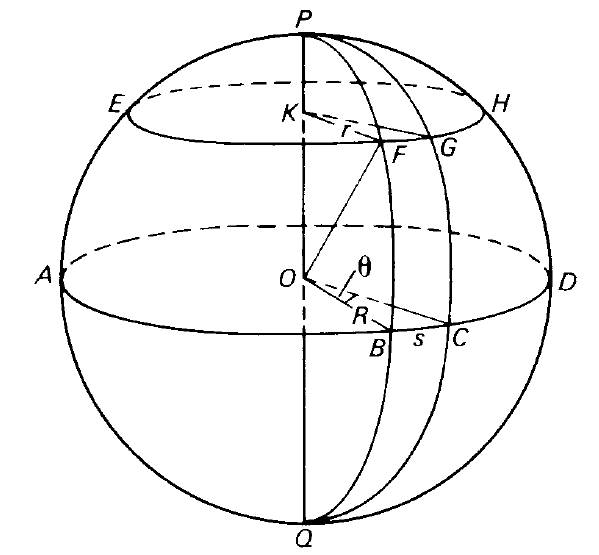


 الفيزياء الكلاسيكية
الفيزياء الكلاسيكية
 الكهربائية والمغناطيسية
الكهربائية والمغناطيسية
 علم البصريات
علم البصريات
 الفيزياء الحديثة
الفيزياء الحديثة
 النظرية النسبية
النظرية النسبية
 الفيزياء النووية
الفيزياء النووية
 فيزياء الحالة الصلبة
فيزياء الحالة الصلبة
 الليزر
الليزر
 علم الفلك
علم الفلك
 المجموعة الشمسية
المجموعة الشمسية
 الطاقة البديلة
الطاقة البديلة
 الفيزياء والعلوم الأخرى
الفيزياء والعلوم الأخرى
 مواضيع عامة في الفيزياء
مواضيع عامة في الفيزياء|
Read More
Date: 1-8-2020
Date: 22-8-2020
Date: 31-8-2020
|
Spherical geometry
The geometry of the sphere is made up of great circles, small circles and arcs of these figures. Distances
along great circles are often measured as angles since, for convenience, the radius of the sphere is made
unity.
A great circle is defined to be the intersection with the sphere of a plane containing the centre of the sphere. Since the centre is equidistant from all points on the sphere, the figure of intersection must be a circle by definition. If the plane does not contain the centre of the sphere, its intersection with the sphere is a small circle.
In figure 1, ABCDA is a great circle. If two points P and Q are chosen to be 90◦ away from all points on the great circle (by drawing the diameter POQ perpendicular to the plane ABCDA), they are said to be the poles of the great circle ABCDA.
The small circle EFGHE was obtained by choosing a point K on the diameter PQ and letting the plane through K and perpendicular to PQ cut the sphere. It is easily shown that the figure produced by this procedure is a circle.
Let PFBQP be any great circle through the poles P and Q. Then, by the construction of EFGH, KF is perpendicular to OK, so that the triangle KFO is right-angled at K. By Pythagoras,
OF2 = OK2 + KF2....... (1)
But OF and OK are both constant (OF is a radius of the sphere and OK is a constant) and, therefore, by equation (1), KF is constant.

Figure 1. The basis of spherical geometry.
By construction, F is any point on figure EFGHE so that all points on EFGHE must be equidistant from K. Since they also lie on a plane, EFGHE must be a circle, centre K. P and Q are also the poles of circle EFGHE. Draw another great circle PGCQP through the poles P and Q to intersect the small circle EFGHE and great circle ABCDA in G and C respectively.
Then the angle between the tangents at P to the great circles PFBQP and PGCQP is said to be the spherical angle at P or angle GPF or angle CPB. A spherical angle is defined only with reference to two intersecting great circles. If three great circles intersect one another so that a closed figure is formed by three arcs of the great circles, it is called a spherical triangle provided that it possesses the following properties:
1. Any two sides are together greater than the third side.
2. The sum of the three angles is greater than 180◦.
3. Each spherical angle is less than 180◦.
In figure 1, therefore, figure PBC is an example of a spherical triangle but figure PFG is not, the latter being excluded because one of its sides (FG) is the arc of a small circle. It may be noted in passing that ΔPBC is a special case where two of the angles, namely ∠PBC and ∠PCB, are right
angles.
The sides of a spherical triangle are expressed in angular measure.
The length s of the arc BC is given in terms of the angle θ it subtends at the centre of the sphere
and the sphere’s radius R by the relation
s = R × θ
where θ is expressed in radians.
It should be remembered that
2π radians = 360 degrees.
Other useful relationships are:

If the radius of the sphere is taken as unity,
s = θ
showing that the length of a great circle arc on a sphere of unit radius is equal to the angle (in circular measure) subtended by this arc at the centre of the sphere.
The length of a small circle arc, such as FG, is related simply to the length of an arc of the great circle whose plane is parallel to that of the small circle.
In figure 1, let r be the radius of the small circle EFGHE. Then
FG = r × ∠FKG.
Also
BC = R × ∠BOC.
Both OB and KF lie on plane PFBQ; KF also lies on plane EFGH while OB lies on plane ABCD . Therefore, KF must be parallel to OB, since plane EFGH is parallel to plane ABCD. Similarly, KG is parallel to OC. Then
∠FKG = ∠BOC.
Hence,
FG = BC × r/R
In the plane triangle KOF, right-angled at K, KF = r ; OF = R. Hence,
FG = BC × sinKOF.
But ∠POB = 90◦ so that we may write alternatively
FG = BC cos FB.
If the radius of the sphere is unity,
PF = ∠POF = ∠KOF
and
FB = ∠FOB,
so that we have
FG = BC sin PF
and
FG = BC cos FB................. (2)



|
|
|
|
علامات بسيطة في جسدك قد تنذر بمرض "قاتل"
|
|
|
|
|
|
|
أول صور ثلاثية الأبعاد للغدة الزعترية البشرية
|
|
|
|
|
|
|
مكتبة أمّ البنين النسويّة تصدر العدد 212 من مجلّة رياض الزهراء (عليها السلام)
|
|
|